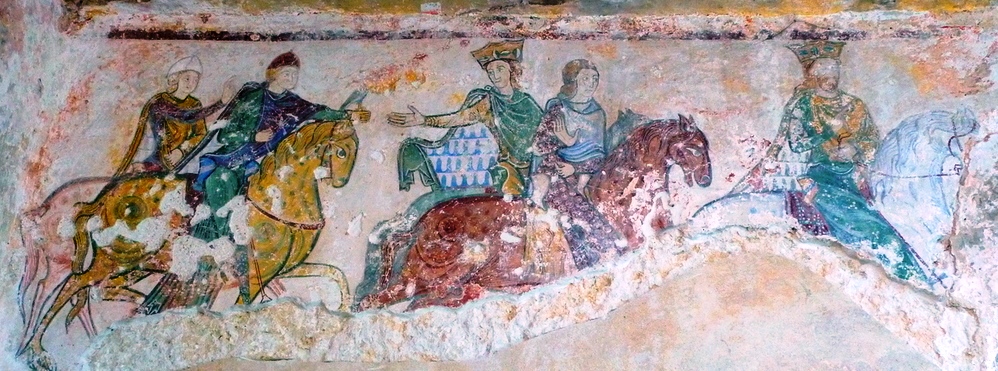Let’s see what those historians and biographers have to say about Eleanor’s appearance:
W.L. Warren in his biography of Henry II calls Eleanor a ‘black-eyed beauty.’ No primary source.
Frank McLynn in Lionheart and Lackland: ‘Eleanor of Aquitaine had a dark complexion, black eyes, black hair, and a curvaceous figure that never ran to fat even in old age.’ No primary source.
Desmond Seward in Eleanor of Aquitaine the Mother Queen: ‘She was a beauty – tall, with a superb figure that she kept into old age, lustrous eyes and fine features. (it is likely that her hair was yellow and her eyes blue).’ No primary source.
Douglas Boyd in Eleanor April Queen of Aquitaine. ‘Her face was humorous and alert, framed by long auburn hair flowing freely from beneath the coronet. Her eyes according to legend were green and fearless.’ No primary source
Alison Weir in Eleanor of Aquitaine, By the wrath of God Queen of England: ‘It is more likely that she had red or auburn hair since a mural in the church of Sainte Radegonde in Chinon which almost certainly depicts Eleanor and was painted during her lifetime in a region in which she was well known, shows a woman with reddish-brown hair.’
Marion Meade in Eleanor of Aquitaine: A biography: ‘Eleanor, exceptionally beautiful at fifteen, had matured into a saucy, hot-blooded damsel, and perhaps he (her father) feared that, unproperly chaperoned, she might grant excessive courtesies to some ardent knight.’…’ If she conformed to 12th century Europe’s ideal standards of feminine beauty…she must have been blond with grey or blue eyes set wide apart. Her nose would have been straight, her skin white, and she would certainly have had a long, slender neck, firm breasts, and perfect teeth…’ No primary source.
The above are all interesting and show what a variation in opinion there is, based either on fantasy or wrong information even though the authors are writing ‘factual’ works. Meade’s comment about a ‘saucy, hot-blooded damsel’ is astonishing. It’s a defamatory statement without any kind of proof, but typical of the various biographies of Alienor through which I’ve ploughed over the last 18 months.
There is not one single physical description of Eleanor from her own timeline as to her hair and eye colour. Not one single. The chapel mural at St. Radegone is more likely not to be Alienor rather than Weir’s ‘almost certainly.’ Far more probable, given the dateline of the mural and the composition, is that Henry is leading out his four sons on a hunting expedition with his eldest son the Young King, the crowned figure. The dark one riding at his side, will be John, whom Henry requested to be cared for by the Young King, should Henry himself die untimely. The John figure also, along with the Young King, is nearest to his father, and John was known to be Henry’s favourite son. It’s pretty obvious that the crowned figure isn’t Alienor. The figures of the other riders are of an age to suggest that when this was painted, she was in prison and out of the picture – literally. However, that particular detail seems to have passed certain biographers by. Art Historian Ursula Nielgen examined the mural in 2004 and arrived at the conclusion from the clothes and other clues that in fact these figures were all men, which fits in with the theory of Henry and his sons out on a hunt. Again, this is only a theory. It can’t be proven who these people are but from the pictorian evidence they are all male.
The black hair, black eyes, and the various droolings over the curvaceous figure would appear to be some sort of modern male wish fulfilment. I haven’t noticed her being particularly buxom or curvaceous on her tomb effigy! Nor is it a portrayal of her in old age as Frank Mclynn seems dubiously to think.
Having completed my research, I changed my mind from my cameo brunette and portrayed her with deep blond hair and blue eyes in my trilogy. My own reasons?
1. My alternative psychic research showed her like this. However, if your opinions don’t encompass such things, then let the matter rest in the same realm of the imagination as the above descriptions by the historians. I’m a novelist and I have more leeway in the invention stakes.
2. Actually there is circumstantial evidence in the historical record. Looking back at Eleanor’s ducal ancestors, one finds the 10th century William the Towhead – i.e. hair the colour of straw. So the blond gene ran in the family – which is more than we actually know about the other colours at this stage!

